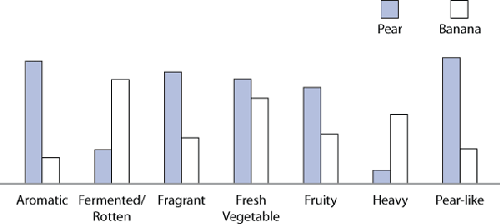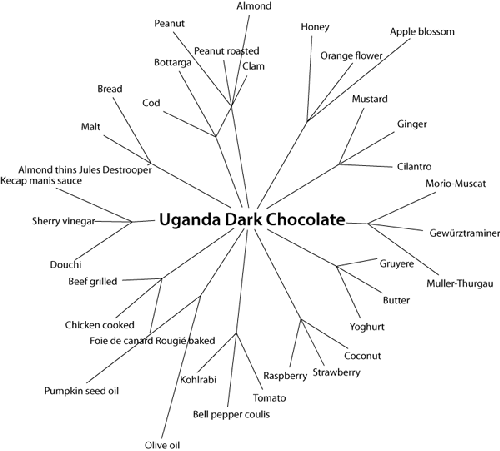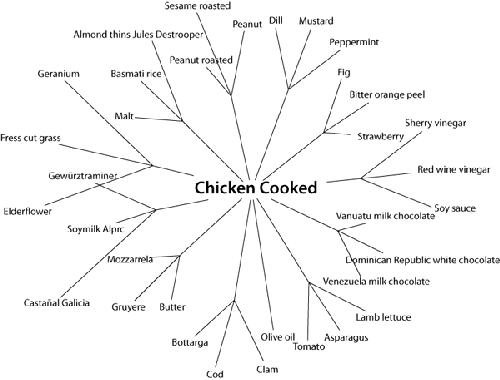There have been a
number of attempts over the years to devise a scientific model for predicting which flavors
will work well together. While not particularly well suited for day-to-day cooking, these
types of approaches do have a place in helping create new combinations of flavors and they
are used by the food industry and some high-end chefs.
Note: A disclaimer: picking pleasing flavors—or at least ones that invoke an emotional
response or trigger a memory—is somewhere between an art and a science, so no scientific
equation can capture the entire picture. Still, understanding how such a “flavor
compatibility algorithm” would work can provide you with a way of organizing your thoughts
on food, and for geeks, it’s fun to see how far one can take these sorts of things. If you
really want to geek out and need a food project to work on, an open source version of this
concept would be fun.
To start, we need a model of how to describe individual flavors, before considering how
to combine them. Odors can be categorized in a few ways, most commonly either chemically or
descriptively. Chemical taxonomies classify compounds by their odors. Such a taxonomy is essentially a
database of chemicals that each map to distinct flavor sensations. For example, Flavornet
(http://www.flavornet.org), created by two researchers at Cornell
(Acree and Arn), describes some 700+ chemical odorants detectable by the human nose. Listing
compounds such as citronellyl valerate (smells like honey or rose; used
in drinks, candies, and ice cream), the database is useful for generating certain flavors
artificially, but not so useful outside of laboratory kitchens. Descriptive taxonomies apply labels to odors as a way of classifying and grouping foods.
For example, both lemon and orange are generally classified as “fruity/citrus.” Lacking the
precision of a chemical taxonomy (the compound is either present or it isn’t), descriptive
taxonomies suffer from the subjectivity of human judgment. Most of us would agree that a
lemon smells “fruity/citrus,” but how much does a food like chocolate smell of the odors in
celery? Not much, but certainly more than chocolate smells of fish.
Note: The simplest descriptive taxonomy, from the 1950s by J. E. Amoore, proposes just seven
primary odors: camphoric (like mothballs), ethereal (like cleaning fluid), floral (like
roses), musky (like aftershave), pepperminty, pungent (like acetic acid in vinegar), and
putrid (like rotten eggs).
One modern
descriptive taxonomy can be found in the American Society for Testing and Materials’
Atlas of Odor Character Profiles – DS61, by Andrew Dravnieks. While
you might not necessarily think of all of the terms included as pleasant, it’s certainly a
diverse set, which is useful in thinking about smells. With 146 terms, Dravnieks’s list also
provides enough granularity to begin to form a meaningful model for food flavors. |
Common
|
Sweet, fragrant, perfumy, floral, cologne, aromatic, musky, incense, bitter,
stale, sweaty, light, heavy, cool/cooling, warm
| |
Foul
|
Fermented/rotten fruit, sickening, rancid, putrid/foul/decayed, dead animal,
mouse-like
| |
General foods
|
Buttery (fresh), caramel, chocolate, molasses, honey, peanut butter, soupy,
beer, cheesy, eggs (fresh), raisins, popcorn, fried chicken, bakery/fresh bread,
coffee
| |
Meats
|
Meat seasoning, animal, fish, kippery/smoked fish, blood/raw meat, meat/cooked
good, oily/fatty
| |
Fruits
|
Cherry/berry, strawberry, peach, pear, pineapple, grapefruit, grape juice,
apple, cantaloupe, orange, lemon, banana, coconut, fruity/citrus,
fruity/other
| |
Vegetable
|
Fresh vegetables, garlic/onion, mushroom, raw cucumber, raw potato, bean,
green pepper, sauerkraut, celery, cooked vegetables
| |
Spices
|
Almond, cinnamon, vanilla, anise/licorice, clove, maple syrup, dill, caraway,
minty/ peppermint, nut/walnut, eucalyptus, malt, yeast, black pepper, tea leaves,
spicy
| |
Body
|
Dirty linen, sour milk, sewer, fecal/manure, urine, cat urine, seminal/like
sperm
| |
Materials
|
Dry/powdery, chalky, cork, cardboard, wet paper, wet wool/wet dog, rubbery/
new, tar, leather, rope, metallic, burnt/smoky, burnt paper, burnt candle, burnt
rubber, burnt milk, creosote, sooty, fresh tobacco smoke, stale tobacco
smoke
| |
Chemicals
|
Sharp/pungent/acid, sour/acid/vinegar, ammonia, camphor, gasoline/solvent,
alcohol, kerosene, household gas, chemical, turpentine/pine oil, varnish, paint,
sulphidic, soapy, medicinal, disinfectant/carbolic, ether/anaesthetic, cleaning
fluid/carbona, mothballs, nail polish remover
| |
Outdoors
|
Hay, grainy, herbal/cut grass, crushed weed, crushed grass, woody/resinous,
bark/ birch, musty/earthy, moldy, cedarwood, oakwood/cognac, rose, geranium
leaves, violets, lavender, laurel leaves
| |
REPRINTED, WITH PERMISSION, FROM DS61 ATLAS OF ODOR CHARACTER
PROFILES, COPYRIGHT ASTM INTERNATIONAL, 100 BARR HARBOR DRIVE, WEST
CONSHOHOCKEN, PA, 19428
|
Dravnieks’s 146 odor terms, broken down into main categories, provide a good
basis for thinking about odors. If you’re heading out on a date and want to impress,
this list is a pretty good starting point for describing wines!
Note: Another adjective
classification system, Allured’s Perfumer’s Compendium, is used by
the perfume industry, the fine folks responsible for the smells of products from laundry
detergent to toothpaste. Think that new car smell is accidental? Trained employees smell
the materials that go into the interior of a new car to make sure that it smells just
right. (To quote The Matrix: “You think that’s air you’re breathing
now?”) Allured’s taxonomy uses more descriptive and narrow scents—familiar items such as
banana, peach, and pear—but also specific items like hyacinth, patchouli, and muguet (lily
of the valley), making it less useful to the layperson.
Let’s start by defining a flavor profile as the weighted scores of a collection of terms
in a classification system, such as Dravnieks’s 146 odor terms. For every term, imagine
taking an item of food—say, a pear—and scoring it on a scale from 1 to 5, where a score of 1
indicates “doesn’t smell like it at all” and 5 is “the very definition of the word!” Given a
pear, how much does it smell like a “heavy” odor? 1. Fruity? Maybe a 3? Fragrant? Say it’s a
ripe pear, so 4. The scoring is not asking if it is a compatible smell, just if the odor label describes
the smell. Are the odors you sense in a pear (are the chemoreceptors that fire off in your
nose) the same as when you smell other things that are considered fragrant? Given the
weights of all of these odor descriptions for a pear, you can plot a graph (almost like a
histogram) that you can then compare to similar graphs for other foods.
Some of Dravnieks’s odor terms associated with banana and pear, as scored
by a few thousand Internet voters (taller bars indicate a larger degree of agreement
between food and odor). These voters were not trained or verified to be familiar with
the definitions of those odors; for these reasons, this graph should be treated as a
conceptual demonstration only.

Given such a graph for each individual
ingredient in a recipe, you can imagine a combined graph that describes the overall profile
of a dish, showing all the “frequencies” present in the smells of each ingredient. Think of
it like the various instruments that contribute to a piece of music: each has its own set of
frequencies, and the combination of all the instruments makes up the overall song’s
frequency distribution. When in tune, the frequencies line up and balance one another; when
out of tune, the combination of sounds can be jarringly dissonant, even if each sounds fine
individually. Of course, this music analogy isn’t a perfect fit for thinking about flavors:
chemical changes brought about by cooking or by reactions between foods change the
histogram, and the music analogy doesn’t cover other variables in foods, such as texture,
weight, or mouth-feel. Many chefs—often pros, but also non-pros who’ve been cooking for years—can imagine
flavor combinations in their heads, doing something similar to this process mentally. Just
as a composer imagines each voice and track in a piece of music, an experienced cook
imagines the profile of the entire dish. Good cooks think about which notes are missing or
are too soft and figure out what ingredients can be added to bring up those values. What about achieving entirely new pairings, combinations that have no precedence in
tradition? This same concept of matching up foods by their flavors can be done via the
chemical taxonomy method, given enough time. The high end of the luxury restaurant industry
spends an inordinate amount of time working on new flavor combinations, often with upward of
two years spent working on a concept before it’s presented. Chef Heston Blumenthal of The
Fat Duck (UK) maintains three distinct kitchens, one of which is devoted to laboratory work
and is staffed by individuals holding both masters-level degrees in hard sciences like
physics or chemistry and degrees from first-tier culinary institutions
such as Le Cordon Bleu. Here is a partial list of pairings Chef
Blumenthal has used: strawberry and coriander, snails and beetroot, chocolate and pink
peppercorn, carrot and violet, pineapple and certain types of blue cheese, banana and
parsley, harissa and dried apricot. Give them a try! In addition to conducting their own private research, high-end chefs interested in
creating new flavor combinations sometimes work with researchers at universities. Both
Flavornet (http://www.flavornet.org) and FoodPairing
(http://www.foodpairing.be) include such research in
their sites. If you’re interested in exploring some of the chemical commonalities between
ingredients, look at FoodPairing, which uses a chemical flavor database in order to suggest
what ingredients to try together. (FoodPairing claims to be used by Chefs Heston Blumenthal
and Ferran Adrià.) 

Food Pairing diagrams for chocolate and chicken. Their database is based
on chemical analysis, and it gives suggestions based on both chemical similarity and
chemicals known to be complementary.
GRAPHS USED BY PERMISSION OF BERNARD LAHOUSSE

The analytical approach tends to be very abstract. There’s little here that helps one
select what ingredients to toss into a bowl together to make dinner. For this reason, these
sorts of tools have yet to become particularly successful. This technique doesn’t generate
recipes. While a set of odors might go together from an aromatic perspective, there are
other variables in cooking that prevent mixing and matching various ingredients
indiscriminately. For example, one ingredient might require cooking, while another might
break down in high heat. You can work around these constraints by separating the two ingredients into different
components that are prepared separately and combined on the plate—say, a meat with a sauce.
Or try using cooking methods that are, in essence, about conveying the perfume in food.
Soups, ice creams, even soufflés: all are methods of transporting the flavors and aromas of
ingredients without carrying the texture or volume of the original ingredient. A number of
more recent, novel flavor pairings have used this solution. At the very least, you might
find these types of tools a fun source of inspiration to try new things. Go
experiment!
|